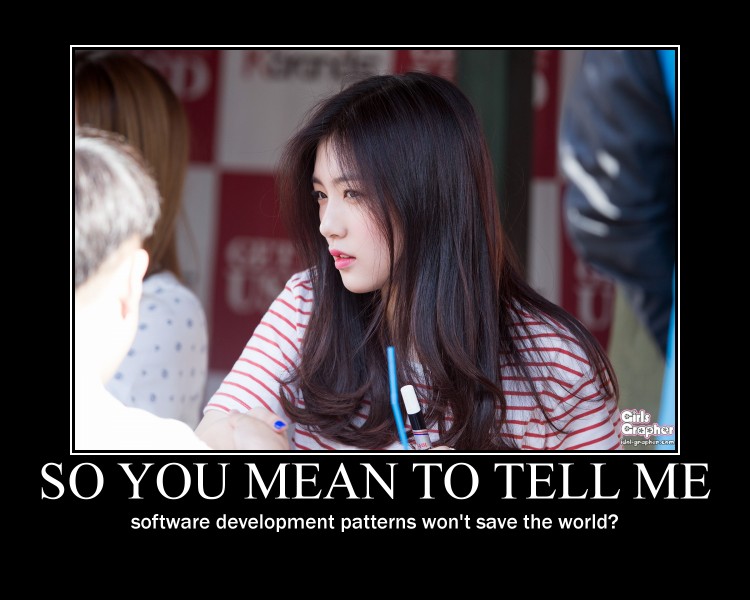Rants from the Ballmer Peak 
Patterns as solution anti-patterns

I don't remember the exact time I crashed against software design patterns. Most likely it was my university days, most of the stuff I learnt there I hated with a passion. But since you can't hate forever, slowly the hate turned into apathy, and at least I stopped trying to run away from them. Recent directives at my current workplace have reminded me of patterns, but now I've tried to understand what drove me crazy about patterns. What makes patterns so vilified by some, or followed blindly by others like a religion? Is there something we can do to avoid the bickering? Are patterns bad per se, good, or neutral? Is it us who wield them incorrectly? If you are bored enough and want to waste your time, follow me along this public introspection. Otherwise my TL;DR for you is patterns can't be taught at will and making them a requirement for software development is usually a bad idea.
Building a fictional situation
Programmers tend to gravitate between two extremes: either those who learn everything by practice (or sometimes reinvent it themselves!), or those who go to a theory source and learn it hard before even thinking of touching a machine. Depending on interest, self improvement, years of experience and environment, people can slide between these extremes. I clearly fall on the learn by practice category because I love getting dirty with code and hate red tape. With such a pedigree, at some point I said the following to other programmers:
Programming is like cooking, you can spend hours looking at a cake recipe and think you have figured it out, but the truth is that until you actually try to make the cake you know nothing.
And they liked it because it resonated with their experience. For those of you who don't cook, recipes are essentially instructions to build stuff. Sometimes more vague, sometimes more detailed, just like many software project requirements. But even after planning, even after years of experience, even after painfully high levels of detail in the spec, all projects end up having surprise unplanned events. Let's face it, we are humans and we can't escape making mistakes either. There is a limit to the amount of in memory planning, or software developing we can do. Just like source code, we can look at it all day round but at some point we have to sit in front of a debugger and figure out why it is not working as we intend it to. To illustrate part of what is wrong with patterns let me build up two different characters coming from both ends of our hypothetical learning behaviour spectrum.

Alice is a hardcore software engineer. She eats assembler and C for breakfast and spits satellite firmware in the evenings. NASA calls her when everything is fucked up because she has this getting things done skill which cuts through bureaucracy like a butter knife through… wait for it: butter. However the deep specialization has put her in an awkward situation, with few job openings for her, so she has decided to look into other software fields to expand her programming expertise.
Bob is on the other hand an ivory tower strategist. He enjoys mastering patterns in a secluded bunker, far away from the battle field noise. Devouring book after book, he has ascended to a middle management position and sends wave after wave of coders to find, corner and annihilate bugs, task, and features with surgical precision, all working in unison like a German clock. He's an expert chess master who would put Kasparov or Deep Blue to great shame. He just doesn't bother proving it, everything plays out perfectly in his mind.
As different as these two engineers are, they end up meeting in a mobile app development environment. Both feel unsure and new to the field. Mobile app development looks like a joke to Alice, all this weird object orientation crap, building layer after layer of stuff which blinds you from the true code and bloats the program reducing precious performance. She resolves to keep coding as usual, as long as the Java compiler doesn't complain about the many global and static class methods. After all, it compiles and it works, right? Bob is also struggling here, some of the management techniques he has learned so far are a little unwieldy for mobile development, and there are new patterns he had not heard of before, like MVVM or VIPER. A reptilian pattern?
The clash between these two different forces of natures happens soon. Bob reviews pull requests and notices Alice writes code which doesn't fit well into typical patterns. This cannot be allowed, so Bob tells Alice that she must take some time to read about patterns and apply them. It's good that software works, but Alice is not working alone, there is also a team who has to understand her code, and at any given time new coders might need to pick up the old code and improve it. How are they going to do that efficiently if the code doesn't follow the usual patterns? Warnings are given, future source code commits will be picked at random and reviewed for compliance. If things are not to his liking, heads will rock and roll.
Ah, well, it's not the first time either Alice has to deal with this kind of guys, so far from earth they wouldn't recognise their own feet. She starts reading some stuff online about patterns and oh boy, there are swaths of them to pick from! Just like at a supermarket there are dozens for each letter of the alphabet. For a new feature, some kind of download manager, resolves to use a finite state machine. In the good old days, with nobody watching over her shoulder a few constants or enums plus a big switch would be enough. But to meet required standards this time applies the State pattern. The result doesn't end up pretty, it's the first time she applies this and the result is a little messy because she doesn't yet grok all the inheritance and getter setter mumbo jumbo, but it seems to work. The performance must be terrible though, the dozens of classes are going to be a pain for the CPU's cache as well as not being able to use constants anywhere because the class instances for each state are dynamic. It's not clear either how splitting a few pages of code over dozens of source files in Java makes it easier for others to understand, it feels like the proliferation of source code files is used only to hide the actual intent of the code. But once it all works she shrugs and moves on to the next task.
After a while Bob takes a look again at source code commits and sees better looking code. Unsure about it, he sits down with Alice and tells her to pick some source code and explain what patter was applied and how. It's showtime, Alice turns up the jargon knob to eleven and explains the state pattern showing all the classes she had to generate. After crossing a line in his lingo bingo card Bob says he has seen enough and is satisfied, praising Alice for doing a good job. "Keep at it and everything will go smoothly for everybody in the company". After this exam Alice relaxes and goes back to her original self, since Bob is now busy instilling the fear of patterns into the hearts of new software engineers joining the company, and figures she's gained enough trust not to be bothered again with such silly requests.
The previous scene filled with hyperbole has several things based on the reality I've experienced multiple times. In no particular order:
- Somebody on the team wants everybody else to move development to a new silver bullet. In this case it would be Bob forcing everybody to use software development patterns (any, regardless of usefulness!). But I've seen it also happens with somebody from the trenches having been recently illuminated by the ray of truth. The new toys problem.
- New silver bullets have the infuriating habit of getting in the way. Thus, external rewards and/or punishments are established to help moving in the good direction. In this case a hypothetical punishment awaits, but maybe you have also heard of being paid per line of code written. The appeal problem.
- Enforcement of the new policy doesn't last long. Either due to interest or lack of resources, the new silver bullet is shortly dropped. Even in those cases where the new policy is kept for some long time (say half a year or more) it usually ends with the person interested in it. Aka, the team doesn't adopt it. The interiorization problem.
- In the act of using patterns, not much was actually learnt or improved. In fact, we can argue that the wrong things were learnt (how to avoid punishment) and the overall result for the software and maintenance was worse. The solution problem.
What are software design patterns anyway?

We can easily find a readable description of software design patterns, quoting from Wikipedia:
In software engineering, a software design pattern is a general reusable solution to a commonly occurring problem within a given context in software design. It is not a finished design that can be transformed directly into source or machine code. It is a description or template for how to solve a problem that can be used in many different situations. Design patterns are formalized best practices that the programmer can use to solve common problems when designing an application or system.
Here is the deal breaker for me: they are a solution to a problem. We can go through the four problems mentioned above, but all of them can be traced to the fact that there was no problem to solve in first place!
The new toys problem
I'm guilty as charged of this. It's way easy to get carried away with a new fad and try to apply it everywhere. Your new screwdriver requires loose screws, and you don't have to look far away to find them. Maybe the best way to mitigate the problem is to experiment first with it without hurting others as this could blow off the steam from the hot novelty. If you have learned about a new pattern, try it first in a small, hopefully limited and personal project were failure is not a problem. Trying to impose a solution to others just because you read a blog somewhere (ahem) is bad. In fact, the best way to convince a technical person is to show them how you solved something. Comparing against the previous way of doing things is usually very effective because measurements and conclusions can be extracted.
In the case of software design patterns the crucial appeal might be the bold claim that patterns are "best practices that blah blah blah blah". Somebody reading such a statement can easily ignore all the caveats in the text around and simply march forward thinking that just by applying patterns everything will be a best practice.
The appeal problem
Let's say that something actually is better. However, how much better is it? Is it quantifiable? How long do you have to wait to see the return on investment? Maybe whatever technique or solution you want to propose to your colleagues has a very long horizon until it materializes. This can explain why others are reluctant to adopt it. If the solution can't be seen to produce a benefit in a short time you are going to have a very difficult way of convincing people. Given that I'm used to projects spanning years, it's not much of a stretch to ask for a solution that proves useful after one month, especially when some firms have a turnover rate that long. The problem might be also one of human nature, a month can be a long time (especially if you are on crunch time) and you just forget what and how you were doing earlier. Do you remember what life was before Google? Which leads us to…
The interiorization problem
Let's say that we can measure the development speed of a team. Does the team using this technique work faster? Does it deliver more lines of code, or features, or epic stories, or whatever jargon you kids are playing with these days? Once you measure that, you have to think back: was it worth it? Most of the times I've seen a solution being enforced and applied successfully, the benefits were lost to the sound of grumbling and teeth gnashing of people reluctant to change. Starting to run in circles here, if there is no appeal to a technique, it is hard to make people interiorize the solution. And if people don't interiorize the solution, they are not going to apply it willingly. Once the carrot is removed or the whip stops you go back to your old self and you merely remember the experience as a waste of time.
The solution problem
The worst of applying a seemingly random solution to a problem is that maybe there was no problem in first place. Or maybe the solution works but it has unexpected second effects, like higher maintenance cost. Or maybe you are using a really superb technique that is so difficult to master few people are able to use it effectively. How big is the pool of developers you can pick from? For example I've wanted for years to be employed in a Nim project, but so far I'm still waiting to meet another human being who knows what Nim is.
In the fable above, a competent developer misuses the state pattern and the source code ends up looking like scorched earth. I've seen this so many times because for some reason I end up maintaining such code and sometimes I'm still able to talk to the original culpr… authors. In most cases I get shrugging and "orders from above" excuse. Really, they might be your minions, but even they have an idea or two on what makes the boat float, so maybe talk to them a little bit and listen to their gripes before imposing something?
The annoying things about patterns
Despite a software design pattern being good and solving a problem, monitoring new changes to guarantee compliance, and spending time to teach other people about patterns, the biggest difficulty is that learning from a third party and experiencing something first hand are different things. Many times in my life I've heard other people more experienced and knowledgeable than me to recommend me something. I agree, say "of course, of course", and when I reach the moment to put this knowledge into practice… I don't do it. Why?
You may have heard of the don't repeat yourself (DRY) principle. To avoid repeating yourself your brain first has to match a pattern. If the thing you are coding is slightly different or has some other externality which seems to make it a separate case, even if you are willing to not repeat yourself you will do so. The same happens with third party advice, no matter how much certain things are read about, until they happen to you it's hard to recognize the situation, and thus reach that portion of your brain which holds the appropriate knowledge for it.
That's the essential problem with patterns. Knowing about them is nice, but even if you read about them you still have to experience the problem they try to solve. And experiencing that usually means consuming time and producing failures, the most solid things to learn from, but also the worst in terms of project scale and deadlines. When a pattern is imposed without the recipient knowing why, or what does it solve, you can sing about it all day but it will fall on deaf ears.
Patterns are really just names we apply to repeated solutions. As such they are nothing more than a taxonomy, they are not a tool themselves. In fact, when I first read about patterns I realized I was already applying some of them, without even knowing. But the most annoying thing was reading about this or that pattern and being left in suspense out of the conversation, only to learn later I actually knew what was being meant. You can tell others you want to go outside to walk on poaceae or gramineae, or you can tell them you want to walk on the grass. Figure out which one of those sentences has a higher chance of antagonizing others.
Conclusion
Patterns could haunt you forever because some people enjoy wielding their name, which is not a very productive behaviour. If you want to talk about a pattern and somebody doesn't know it, don't be a dick and explain it rather than stating aloud how uneducated people are these days, or what good is the salary being paid to the victim. Also, don't explain what the pattern is, explain what kind of situation it is trying to solve. Applying a pattern is a matter of experience, if the people receiving the new knowledge don't seem to get it, don't force them to use it. Monitor their code and let them fail a little, starting to derail from the optimal path. Once the problem is visible, explain where it is and how applying the pattern can help.
It is harder to do, it takes much longer, and you need a high willpower to do it. But if you teach patterns through mistakes, always applied to recent experiences, patterns will stop being a silver bullet and will look more like the library of knowledge programmers should visit from time to time to review and improve their skills. It's a place you should go willingly, putting a gun to your head won't help.

$ cat advice.txt > /dev/null